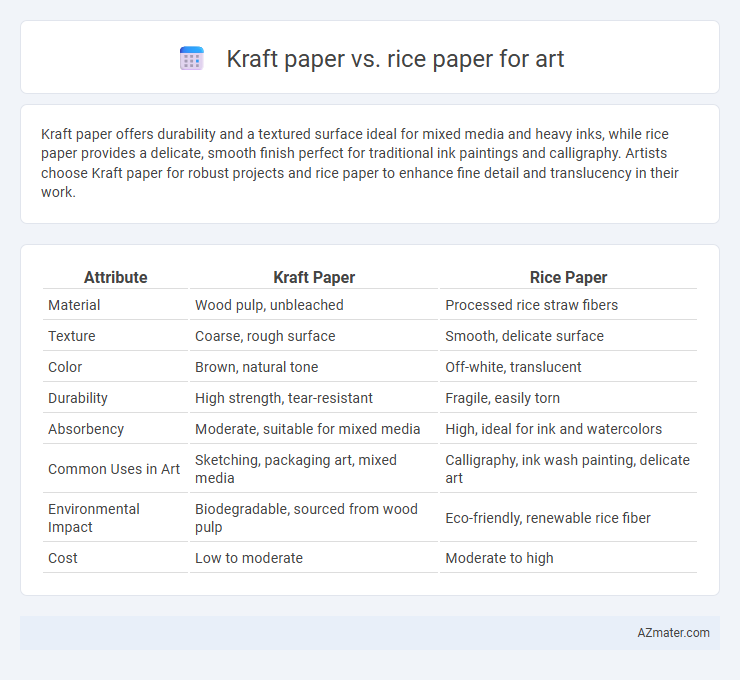Kraft paper offers durability and a textured surface ideal for mixed media and heavy inks, while rice paper provides a delicate, smooth finish perfect for traditional ink paintings and calligraphy. Artists choose Kraft paper for robust projects and rice paper to enhance fine detail and translucency in their work.
Table of Comparison
| Attribute | Kraft Paper | Rice Paper |
|---|---|---|
| Material | Wood pulp, unbleached | Processed rice straw fibers |
| Texture | Coarse, rough surface | Smooth, delicate surface |
| Color | Brown, natural tone | Off-white, translucent |
| Durability | High strength, tear-resistant | Fragile, easily torn |
| Absorbency | Moderate, suitable for mixed media | High, ideal for ink and watercolors |
| Common Uses in Art | Sketching, packaging art, mixed media | Calligraphy, ink wash painting, delicate art |
| Environmental Impact | Biodegradable, sourced from wood pulp | Eco-friendly, renewable rice fiber |
| Cost | Low to moderate | Moderate to high |
Overview: Kraft Paper vs Rice Paper in Art
Kraft paper features a coarse texture and high durability, making it ideal for sketching, mixed media, and heavy-duty art projects, while rice paper offers a smooth, delicate surface favored for traditional Asian calligraphy, watercolor, and brush painting due to its absorbency and lightweight nature. Kraft paper's brown, earthy tone provides a rustic backdrop that enhances pencil and charcoal drawings, whereas rice paper's translucent quality allows for layering effects and intricate detailing. Artists select between these papers based on the medium, texture preference, and desired visual impact in their artwork.
Material Origins and Composition
Kraft paper is made from wood pulp derived from softwood trees through the kraft process, resulting in strong, coarse fibers with high tensile strength ideal for heavy-duty art projects. Rice paper, traditionally crafted from the pith of the Tetrapanax papyrifer plant or processed from rice straw, features a delicate, lightweight texture that absorbs ink and watercolor well, making it preferred for calligraphy and delicate paintings. The cellulose fiber content and processing methods define their distinct durability and surface qualities, influencing their suitability for different artistic techniques.
Texture and Surface Qualities
Kraft paper offers a coarse texture with a natural, fibrous surface that enhances tactile depth and absorbs ink and paint unevenly for a rustic effect. Rice paper, in contrast, features a smooth, delicate surface with slight translucency, ideal for fine detail work and ink wash techniques. Artists choose kraft paper for its durability and textured dimension, while rice paper excels in subtle brushwork and layering effects.
Durability and Longevity
Kraft paper offers superior durability and longevity compared to rice paper, making it ideal for artworks requiring strength and resistance to tearing. Its coarse fibers and dense texture provide excellent archival qualities, ensuring the artwork remains intact over time. Rice paper, while delicate and favored for calligraphy and ink wash painting, is more prone to wear and requires careful handling and preservation to maintain its integrity.
Suitability for Different Art Mediums
Kraft paper offers a durable, heavyweight surface ideal for mixed media, acrylics, and charcoal, absorbing pigments well without warping, making it suitable for rough, textured art styles. Rice paper, with its delicate, smooth texture, excels in ink, watercolor, and calligraphy where precision and fluid brushstrokes are essential, but it may not withstand heavy applications or wet mediums as effectively. Artists should choose kraft paper for robustness and versatility, while rice paper suits detailed, minimalist, and traditional Asian art techniques requiring fine detail and translucence.
Color Absorption and Pigment Behavior
Kraft paper has a rough, fibrous texture that enhances color absorption, allowing pigments to anchor deeply and showcase rich, vibrant hues ideal for mixed media. Rice paper possesses a smooth, delicate surface that creates subtle pigment dispersion, producing soft gradients and a translucent effect favored in calligraphy and watercolor painting. The absorbency of kraft paper results in more saturated colors, whereas rice paper's minimal absorption encourages pigment pooling and gentle blending.
Ease of Handling and Flexibility
Kraft paper offers superior ease of handling due to its sturdy texture and resistance to tearing, making it ideal for sketching and rough drafts. Rice paper provides exceptional flexibility with its thin, delicate composition, allowing for smooth ink absorption and fine brushwork in calligraphy and watercolor painting. Artists often choose kraft paper for structural support, while rice paper is preferred for detailed, fluid artwork requiring gentle manipulation.
Environmental Impact and Sustainability
Kraft paper is made from wood pulp and is biodegradable, recyclable, and often produced with sustainable forestry practices, making it an eco-friendly choice for artists seeking durability and environmental responsibility. Rice paper, traditionally crafted from the fibers of the rice plant or mulberry tree, is highly biodegradable and compostable, offering a minimal environmental footprint but often sourced from less industrialized processes that support small-scale sustainability. Both papers provide sustainable options in art, with Kraft paper favoring industrial-scale recyclability and strength, while rice paper excels in natural fiber renewal and low-impact production.
Cost Comparison and Accessibility
Kraft paper generally offers a more cost-effective option for artists due to its widespread availability and lower price point compared to rice paper. Rice paper, often sourced from specific Asian markets, tends to be pricier and less accessible in mainstream art supply stores. This price disparity makes Kraft paper a preferred choice for large-scale projects or practice work, while rice paper is favored for specialized techniques despite its higher cost and limited accessibility.
Choosing the Right Paper for Your Art Style
Kraft paper offers a sturdy, textured surface ideal for bold, mixed-media artwork and sketching with charcoal or pastels, enhancing the depth of darker tones. Rice paper, prized for its delicate, absorbent quality, suits traditional ink, watercolor, and calligraphy, allowing colors to flow smoothly and blend naturally. Selecting between kraft and rice paper depends on your art style's medium and desired texture, ensuring your creative expression is both supported and enhanced.

Infographic: Kraft paper vs Rice paper for Art
 azmater.com
azmater.com